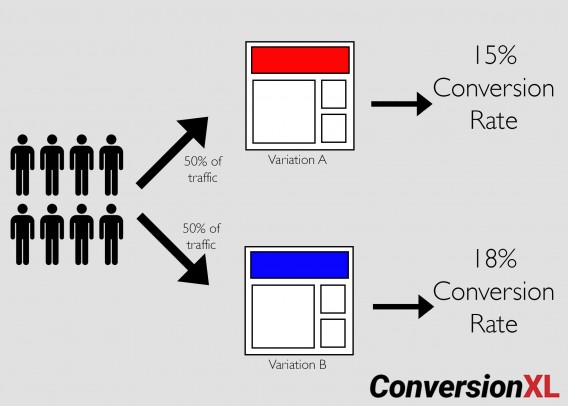In the fast-paced world of online commerce, mastering the art of A/B testing has become essential for businesses aiming to thrive in the digital marketplace. With its array of techniques and strategies, A/B testing offers a pathway to enhancing the performance of online businesses. In today’s competitive landscape, embracing A/B testing isn’t just a choice. It’s a strategic imperative for those seeking career advancement and sustained growth in the e-commerce realm. As such, this article will explore E-commerce A/B testing, in what it is and how the process works.
What is A/B Testing?

A/B testing is a method of comparing two different versions of a webpage or app and observe which one performs better.People also refer to it as split testing or bucket testing. In essence, A/B testing involves experimenting by randomly presenting consumers with two or more variations of a website. Statistical analysis then identifies the variation that converts the highest.
Online businesses can gather information on the effects of changes to your website or app by doing an A/B test that directly compares a variant against the current experience. Also, this allows them to ask targeted questions regarding potential changes.
Testing eliminates uncertainty from website optimization and allows for data-driven decisions that move business discussions from “we think” to “we know.” You can make sure that every change yields benefits by tracking how changes affect your KPIs.
A/B Testing Process – E-commerce A/B Testing
Gather information:
Frequently, analytics platforms may offer guidance on where to start optimizing. To enable online businesses to collect data more quickly. It helps to start with high traffic regions of their website or application. Make careful to search for sites with high bounce or drop-off rates that can be improved when optimizing for conversion rates. When looking for fresh areas for improvement, examine additional resources such as surveys, social media, and heatmaps.
Establish objectives:
The measurements used to assess whether the variant is more successful than the original version are the conversion goals. So, goals can range from making a purchase of a product to simply clicking a button or link.
Come up with a test hypothesis – E-commerce A/B Testing
After deciding on a target, analysts may start coming up with concepts for A/B testing and test hypotheses as to why they believe they would outperform the current iteration. Additionally, after compiling a list of ideas, order them according to anticipated impact and implementation difficulties.
Create different variations:
Online businesses can make the needed modifications to a feature of their website or mobile app by using A/B testing software. This could be something as simple as hiding navigation components, altering the color of a button, or modifying the order of elements on the page template. Also, a visual editor found in many top A/B testing software will make these modifications simple. So, verify that the various versions of your experiment perform as intended by doing a test run.
Conduct an experiment:
Start the experiment and watch for participants to come in. Visitors to the website or application will now be randomized at random to either the control group. Or the variation group based on their experience. To ascertain how well each performs, their interaction with each event is counted, measured, and compared to the baseline.
Await the test findings:
Getting a suitable result may take some time, depending on the size of the target audience and sample size. When an experiment produces reliable and statistically significant findings, analysts will be able to tell. If not, it would be difficult to determine whether the modification actually had an effect.
Examine the outcomes:
After the experiment is finished, the data has to be examined. So, the data from the trial will be shown by the A/B testing software. Which will also indicate whether there is a statistically significant difference between the two versions of the page’s performance. 
Conclusion: E-commerce A/B Testing
Finally, it becomes clear that A/B testing is an essential tool for online companies negotiating the intricacies of the digital economy. Additionally, businesses can make data-driven decisions by carefully comparing different versions of webpages or apps, which provides them with priceless insights into user behavior. This procedure promotes ongoing user experience improvement in addition to increasing conversion rates.
Moreover, the importance of A/B testing in today’s competitive environment cannot be emphasized—it is essential to success and professional growth in the e-commerce industry.
Adopting this strategy gives companies the ability to stay ahead of the curve, resulting in steady growth and opening up new avenues for optimization and innovation.









[…] of the most effective ways to optimize your social media ad campaigns is through A/B testing. This involves running multiple variations of your ad simultaneously to see which performs […]
[…] additionally gives sellers access to historical SERP data for a brand, lets them compare domains, tracks the advertising strategies of competitors, and optimizes both new and old […]
[…] harnessing the power of different ad formats, leveraging advanced targeting options, implementing A/B testing and iterative optimization, and staying up-to-date with industry trends, you can unlock the full […]
[…] to measure the incremental impact of Amazon DSP campaigns on overall sales performance. Implement A/B testing methodologies to assess the lift in key performance indicators (KPIs), such as sales, conversions, […]
[…] the heart of every successful e-commerce venture lies a relentless focus on customer satisfaction. So,use the setback of your account […]
[…] testing is a powerful technique for optimizing your campaigns. ActiveCampaign’s A/B Testing Reports let you test different variations of your emails, such as subject lines, content, and calls […]
[…] best results, regularly test and analyze the performance of your landing page. Additionally, use A/B testing to compare different versions of your landing page and determine which elements drive higher […]
[…] you track metrics such as page views, conversion rates, and visitor behavior. Additionally, the A/B testing feature allows you to create multiple versions of your landing page and test different elements to […]
[…] A/B testing is a crucial strategy for optimizing your funnels. With ClickFunnels, you can easily set up A/B tests to compare different versions of your pages, headlines, or offers. Additionally, by testing and analyzing which variations perform better, you can make data-driven decisions to refine your funnel and maximize conversions. […]
[…] improvement is key to maximizing engagement. Beehiiv’s A/B testing capabilities allow you to experiment with different elements of your newsletters, from subject […]
[…] Features: Free tools often come with restricted functionalities. Advanced features such as A/B testing, advanced analytics, and extensive customization options may be […]
[…] tools to track your funnel’s performance and identify areas for improvement. Also, conduct A/B tests on different elements of your funnel to see what resonates best with your […]
[…] rates by 25% by switching to mobile-first designs and incorporating personalized greetings and A/B-tested […]
[…] test different elements of your emails. Whether it’s the subject line, design, or timing, A/B testing provides valuable insights into what works […]
[…] of the best ways to find out what works is through A/B testing. Also, test different subject lines, email formats, and even sending times to see which variables […]
[…] A/B testing allows you to experiment with different strategies, helping you understand what resonates with your audience and optimizing your emails for better results. […]
[…] A/B testing involves running two versions of an ad or landing page to see which performs better. […]
[…] Different Elements: Conduct A/B tests on headlines, CTAs, images, and copy to see what resonates best with your […]
[…] and Learn: Use A/B testing to experiment with messaging, designs, and offers. Monitor the results and adapt as […]
[…] essential to continuously test and measure the effectiveness of your campaigns. A/B testing, for example, allows you to compare different versions of a campaign to see which performs best. By […]
[…] you could test two different subject lines to see which one results in a higher open rate. A/B testing can also be used […]
[…] A/B testing, also known as split testing, is a valuable method for evaluating the effectiveness of changes made to products, websites, or marketing campaigns. By comparing two versions of a variable (such as a webpage, advertisement, or email), businesses can determine which one performs better based on specific metrics like conversion rates or click-through rates. […]
[…] A/B testing and multivariate analysis, businesses can evaluate which marketing messages, designs, or channels […]